Related Research Articles
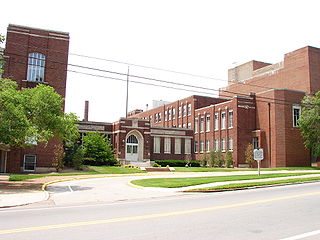
Meharry Medical College is a historically black medical school affiliated with the United Methodist Church and located in Nashville, Tennessee. Founded in 1876 as the Medical Department of Central Tennessee College, it was the first medical school for African Americans in the South. This region had the highest proportion of this ethnicity, but they were excluded from many public and private segregated institutions of higher education, particularly after the end of Reconstruction.

Mount Olivet Cemetery is a 206-acre (83 ha) cemetery located in Nashville, Tennessee. It is located approximately two miles East of downtown Nashville, and adjacent to the Catholic Calvary Cemetery. It is open to the public during daylight hours.

The curse of Cain and the mark of Cain are phrases that originated in the story of Cain and Abel in the Book of Genesis. In the stories, if someone harmed Cain, the damage would come back sevenfold. Some interpretations view this as a physical mark, whereas other interpretations see the "mark" as a sign, and not as a physical mark on Cain himself. The King James Version of the Bible reads "set a mark upon Cain."
Interstate 40 (I-40) is part of the Interstate Highway System that spans 2,556.61 miles (4,114.46 km) from Barstow, California to Wilmington, North Carolina. In the U.S. state of Tennessee, I-40 traverses the entirety of the state from west to east, running from the Mississippi River at the Arkansas border to the northern base of the Great Smoky Mountains at the North Carolina border. At a length of 455.28 miles (732.70 km), the Tennessee segment of I-40 is the longest of any state on the route, and the longest interstate highway in Tennessee. It is also the only interstate highway to completely span the state from west to east.
Walter Strother Davis was an American football coach and college administrator. He was the second president of Tennessee State University, a historically black university in Nashville, Tennessee, from 1943 to 1968.
The following is a timeline of the history of the city of Memphis, Tennessee, US.
The 1919 Vanderbilt Commodores football team represented Vanderbilt University in the 1919 college football season. The 1919 season was Dan McGugin's 15th year as head coach. McGugin was returning from his stent in the Army during World War I where he was relieved by interim head coach Ray Morrison. Josh Cody was selected third-team All-America by Walter Camp, for the second time.
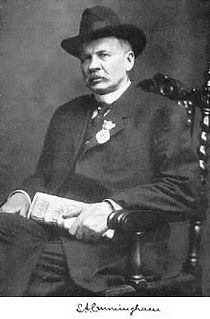
Sumner Archibald Cunningham was an American Confederate soldier and journalist. He was the editor of a short lived Confederate magazine called "Our Day" (1883-1884) published in New York. In 1893 he established the Confederate Veteran, a bimonthly magazine about veterans of the Confederate States Army until his death in 1913.
Herbert Charles Sanborn was an American philosopher, academic and one-time political candidate. He received his PhD from the University of Munich in Germany and briefly taught at Washington College. He was the Chair of the Department of Philosophy and Psychology at Vanderbilt University in Nashville, Tennessee from 1921 to 1942, and he served as the president of the Nashville German-American Society. In his retirement, he continued to coach the Vanderbilt Fencing Team. He ran for the Tennessee State Senate unsuccessfully in 1955. He was opposed to the Civil Rights Movement, and he published antisemitic pamphlets.
For the Missouri politician, see Robert A. Young.

William Crawford Smith was an American architect who served in the Confederate States Army during the American Civil War and in the United States Army during the Philippine–American War. He designed many buildings in Nashville, Tennessee, including Kirkland Hall, the first building on the campus of Vanderbilt University, and the Parthenon in Centennial Park.

Eben S. Stearns (1819–1887) was an American educator. He served as the President of Framingham State University from 1849 to 1855, and as the Chancellor of the University of Nashville and President Peabody Normal School from 1875 to 1887.
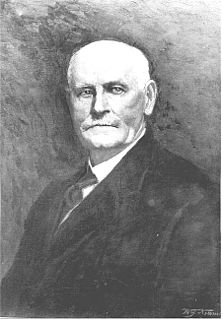
John Trotwood Moore (1858–1929) was an American journalist, writer and local historian. He was the author of many poems, short stories and novels. He served as the State Librarian and Archivist of Tennessee from 1919 to 1929. He was "an apologist for the Old South", and a proponent of lynching.
The 1907 Virginia Cavaliers football team represented the University of Virginia in the 1907 college football season.
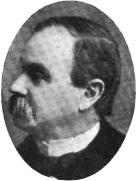
Gates Phillips Thruston was an American lawyer and businessman. Born in Ohio, he served in the Union Army during the American Civil War and started a legal practise in Nashville, Tennessee in the postbellum era. He served as the president of the State Insurance Company. He also was an amateur archeologist, and the author of several books about Native American mounds and artifacts. His collection is held at the Tennessee State Museum and Vanderbilt University.
Benjamin F. Cockrill Jr. (1866–1936) was an American farmer and politician.
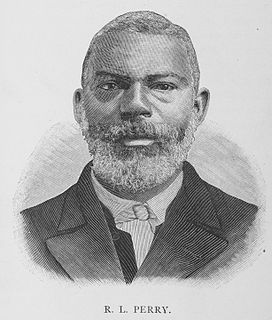
Rufus L. Perry was an educator, journalist, and Baptist minister from Brooklyn, New York. He was a prominent member of the African Civilization Society and was a co-founder of the Howard Colored Orphan Asylum, which developed from it. He was the editor of numerous newspapers and journals, most notably the National Monitor. He was a prominent Baptist, and in 1886 he founded the Messiah Baptist Church, where he was pastor until his death. He was also a classical scholar.
Fountain E. Pitts was an American Methodist minister and Confederate chaplain. He established Methodist missions in Brazil and Argentina in 1835–1836. During the American Civil War, he was a chaplain and colonel in the Confederate States Army, and he became known as the "Fighting Parson". After the war, he was the first pastor of the McKendree Church in Nashville, Tennessee, U.S. He also grew poppies to make opium.
The 1946 Tennessee A&I Tigers football team represented Tennessee Agricultural & Industrial State College as a member of the Midwest Athletic Association (MAA) during the 1946 college football season. In their third season under head coach Henry Kean, the Tigers compiled a 10–1 record, won the MAA championship, shut out six of eleven opponents, defeated West Virginia State in the Derby Bowl and Louisville Municipal in the Vulcan Bowl, and outscored all opponents by a total of 247 to 61. The team played its home games at Tennessee State Stadium and Sulphur Dell in Nashville, Tennessee.
Sarah L. Wilkerson Freeman is an American historian and curator who is a professor of history at Arkansas State University. She co-edited Tennessee Women: Their Lives and Times, a two-volume series with historian Beverly Greene Bond and has written on Southern women's activism from the Progressive Era to the McCarthy Era. Her curatorial work has focused on little-known chapters in Southern history, which included the fluidity of race, gender, and sexuality in 1950s New Orleans and Japanese internments in Arkansas in the 1940s.
References
- 1 2 3 4 5 6 "Pity He's Gone". The Morning Astorian. Astoria, Oregon. June 3, 1883. p. 4. Retrieved November 26, 2015– via Newspapers.com.

- 1 2 "Payne, Buckner H. 1799-1883". WorldCat . Retrieved November 26, 2015.
- 1 2 3 4 Friedman, David M. (2001). A Mind of Its Own: A Cultural History of the Penis. New York City: Simon and Schuster. p. 113. ISBN 0684853205. OCLC 47271694.
- 1 2 3 4 Wood, Forrest G. (1968). Black Scare: The Racist Response to Emancipation and Reconstruction. Berkeley, California: University of California Press. pp. 6–7. OCLC 797646080.
Buckner H. Payne.
- 1 2 "Death of Col. Buckner H. Payne". The New York Times. June 8, 1883. Retrieved November 27, 2015.
- 1 2 3 "Ariel Ascends to the Aereal". The Farmer and Mechanic. Raleigh, North Carolina. June 13, 1883. p. 3. Retrieved November 26, 2015– via Newspapers.com.

- 1 2 Kidd, Colin (2006). The Forging of Races: Race and Scripture in the Protestant Atlantic World, 1600–2000. Cambridge, UK: Cambridge University Press. p. 149. ISBN 0521793246. OCLC 64427347.
- 1 2 3 "General". The Biblical Recorder. Raleigh, North Carolina. June 13, 1883. p. 3. Retrieved November 26, 2015– via Newspapers.com.

- ↑ Speer, William S. (1888). Sketches of prominent Tennesseans. Containing Biographies and Records of Many of the Families Who Have Attained Prominence in Tennessee. Nashville, Tennessee: A.B. Tavel. pp. 414–416.
- ↑ Mohr, Clarence L. (February 10, 2003). "Harrison Berry (1816-ca. 1882)". New Georgia Encyclopedia. Retrieved November 26, 2015.
- 1 2 3 4 5 "Death of a Singular Character". The Record-Union. Sacramento, California. June 2, 1883. p. 1. Retrieved November 26, 2015– via Newspapers.com.

- 1 2 "The Payne Murder Case in the Supreme Court". Nashville Union and American. Nashville, Tennessee. February 28, 1868. p. 3. Retrieved November 26, 2015– via Newspapers.com.
